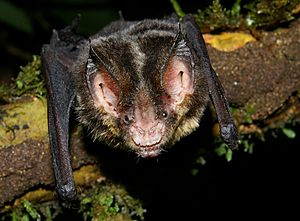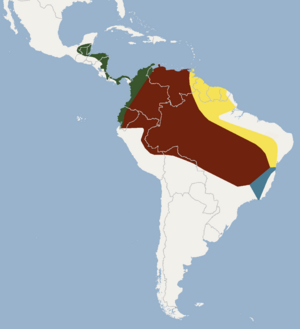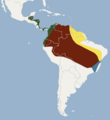Striped hairy-nosed bat facts for kids
Quick facts for kids Striped hairy-nosed bat |
|
|---|---|
 |
|
| Conservation status | |
| Scientific classification | |
| Genus: |
Mimon
|
| Species: |
crenulatum
|
 |
|
| Range map | |
The striped hairy-nosed bat (Mimon crenulatum) is a fascinating type of bat. These bats live in parts of South America and Central America. They can be found in countries like Brazil, Colombia, Ecuador, French Guiana, Guyana, Suriname, and Venezuela. They are known for their unique appearance, especially the "hairy nose" part of their name.
Contents
What is a Striped Hairy-Nosed Bat?
Striped hairy-nosed bats are small mammals. They belong to a group of bats called Phyllostomidae. This family is also known as the New World leaf-nosed bats. These bats often have a special leaf-like shape on their nose. This nose-leaf helps them with echolocation. Echolocation is how bats "see" with sound.
Physical Features of the Bat
These bats get their name from their looks. They have stripes on their fur. Their nose has a unique, hairy texture. This helps them stand out from other bat species. They are usually small in size. Their wings are made of thin skin. This skin stretches between their long fingers and body.
How Big Are They?
Striped hairy-nosed bats are not very large. They are usually about the size of a small bird. Their body length is typically a few inches. Their wingspan can be much wider. This allows them to fly quickly and easily through the forest.
Where Do Striped Hairy-Nosed Bats Live?
These bats live in warm, tropical areas. Their home is mainly in the rainforests of Central and South America. They prefer places with lots of trees. These trees provide safe spots for them to rest during the day. They also offer plenty of insects to eat at night.
Bat Habitats and Roosts
Striped hairy-nosed bats often roost in hollow trees. They might also use caves or abandoned buildings. A roost is a safe place where bats sleep. They hang upside down while they rest. This position helps them take flight quickly. It also keeps them safe from predators.
Climate and Environment
The areas where these bats live are usually humid. They have a lot of rainfall. This climate supports dense forests. These forests are full of insects. Insects are the main food source for many bat species. The bats play an important role in these ecosystems.
What Do Striped Hairy-Nosed Bats Eat?
Striped hairy-nosed bats are insectivores. This means they eat insects. They are very good at catching flying insects in the dark. They use their amazing echolocation skills to find their prey. Their diet helps control insect populations.
Hunting at Night
Bats are nocturnal animals. They are most active at night. When the sun sets, these bats leave their roosts. They fly through the forest looking for food. They use high-pitched sounds to create a "sound map" of their surroundings. This helps them find tiny insects.
Common Prey
Their diet includes many types of insects. They might eat moths, beetles, and mosquitoes. By eating these insects, bats help humans. They reduce the number of pests that can harm crops. They also help control insects that carry diseases.
Life Cycle and Reproduction
Like all mammals, striped hairy-nosed bats reproduce by giving birth to live young. Bat mothers usually have one baby at a time. The baby bat is called a pup. Pups are born tiny and helpless.
Raising Bat Pups
A mother bat cares for her pup. She feeds it milk. Pups cling tightly to their mother. They stay with her until they can fly and hunt on their own. This takes several weeks or months. Young bats learn important survival skills from their mothers.
Bat Lifespan
The exact lifespan of a striped hairy-nosed bat is not well known. However, many bat species can live for several years. Some even live for more than a decade. This depends on their environment and food supply.
Conservation Status
The striped hairy-nosed bat is currently listed as "Least Concern" (LC). This status is given by the International Union for Conservation of Nature (IUCN). "Least Concern" means that the species is not currently at high risk of extinction.
Threats to Bats
Even though they are "Least Concern," bats still face challenges. Their habitats can be destroyed. Forests are sometimes cut down for farming or building. This loss of habitat can make it harder for bats to find food and shelter.
How We Can Help Bats
Protecting bat habitats is very important. We can help by preserving forests. Reducing pesticide use also helps. Pesticides can harm the insects bats eat. Learning more about bats helps people understand their importance. Bats are a vital part of our planet's ecosystems.
Images for kids
See also
 In Spanish: Mimon crenulatum para niños
In Spanish: Mimon crenulatum para niños




